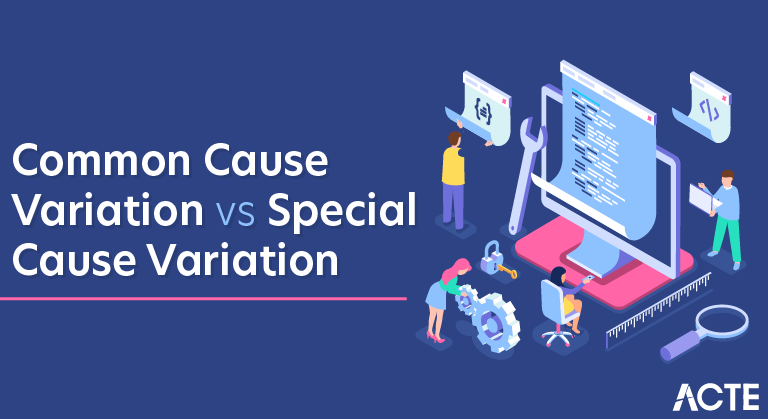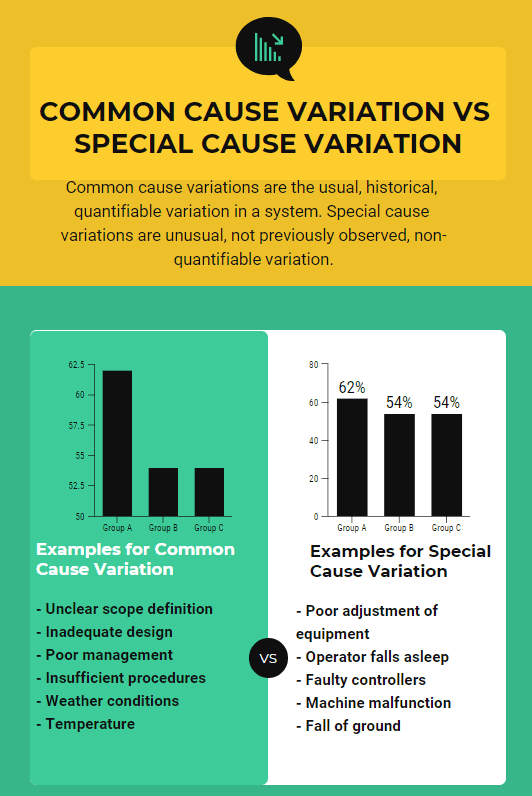
Common cause variation is fluctuation caused by unknown factors resulting in a steady but random distribution of output around the average of the data. It is a measure of the process potential, or how well the process can perform when special cause variation removed.
Common cause variability is a source of variation caused by unknown factors that result in a steady but random distribution of output around the average of the data. Common cause variation is a measure of the process’s potential, or how well the process can perform when special cause variation is removed. Therefore, it is a measure of the process technology. Common cause variation is also called random variation, noise, noncontrollable variation, within-group variation, or inherent variation. Example: Many X’s with a small impact.
Common cause variation is the remaining variation after removing the special causes (non-normal causes) due to one or more of the 5Ms and an “E” causes (Manpower, Material, Method, Measurement, Machine, and Environment), also known as 6Ms (Manpower, Mother nature, Materials, Method, Measurements or Machine).
Common Cause Variation
Common cause variation is variation resulting from factors that may or may not be known, but the final impact they have on your output is predictable and controllable, and you would usually know to expect some variation in specific areas when looking at your final reports. As we said above, some level of variation is inevitable for most types of processes, and this is usually the kind you want to have if you want to be sure that you’re in control of the current situation.
Note that in some cases, common cause variation can still be quite high, and this might cause issues in your production. Take steps to reduce it if you are able to identify the root causes, but don’t stress too much if you can’t get to the bottom of the situation.
Definition of Variation (Special Cause):
Unlike common cause variability, special cause variation is caused by known factors that result in a non-random distribution of output. Also referred to as “exceptional” or “assignable” variation. Example: Few X’s with big impact.
Special cause variation is a shift in output caused by a specific factor such as environmental conditions or process input parameters. It can be accounted for directly and potentially removed and is a measure of process control.
Special Cause Variation
On the other hand, special cause variation occurs when something out of the ordinary happens in a process. This might be a one-time occurrence, or it can develop into a repeating effect, in which case it might eventually be categorized as common cause variation depending on the circumstances. It’s important to understand that sometimes you will simply not be able to avoid special cause variation, either because the nature of a process is prone to it, or because of external factors in your environment that are beyond your control.
When you’ve identified special cause variation though, it’s important to take prompt steps to deal with it. It may not be such a problematic factor right now, but if you leave it unattended for a long time, this might be a real problem that can bring down some parts of your operations. There are some tools that can help you figure out where some issues are coming from, but you may need to come up with some solutions of your own in some cases, depending on the complexity of the situation.
We recently had the pleasure of doing a home exchange with a couple in Paris, France. Unlike Phoenix, Paris has a phenomenal public transportation system. By using the Metro, we were able to travel all over the city and visit a lot of great locations.
At the Metro stations, there is a reader board next to each track telling when the next train will arrive.
The trains arrive anywhere from four to five minutes apart. These variances would be considered from common, or random, causes.
However, on my birthday (a particularly cold night), we go down to the Metro station to get our train back to our arrondissement, check the reader board, and see that the train is delayed by 25 minutes due to a mechanical failure.
This variance would be considered from a special, or assignable, cause.

What are the causes of variation in quality control or what are the types of variation? The term “variation” is widely used in statistics, quality management, genetics, and even in biology. It refers to the measurement for a group of numbers that spread out from their average value. Every measured data set involves some degree of variation even if the degree is slight. It is a numerical value specifies how widely data in a data set vary. A small variance shows that data are closer to the average and a high variance shows that data are very different than each other. There are two causes of variation in quality control which are Common Cause Variation and Special Cause Variation. In this article, we will give examples of common cause of variance and special cause of variance for the control chart.
In day-to-day business, there are some occasional issues that warrant a major corrective response and others that do not. We alluded to this in our prior example, pointing out that major response to normal traffic in a city is not needed; it is normal. A disruptive sinkhole does require alternative strategy.
Our focus here is the common. Other examples of common cause variation are a printer running out of paper, an assembly line arm needed to pause for regular maintenance, or a freight truck needing an oil change. These things can cause small variations in production time, but they are expected and planned for. They are not a surprise. An organization does not need to hold a conference call to decide how to respond to an empty printer. A worker pauses, grabs another ream, and pops it in. Back to business.
One other note is that variations can also be positive, warranting a good change in process. But that is a topic for the special variance section.
One might think that a major key to business success is avoiding trouble altogether. However, consider this simple law of physics: Every moving object faces a level of resistance. All the same, any time we are moving–whether it be toward our personal goals or business goals–there will be problems in our way that we must decide how to handle.
The issue at hand is not how to avoid all trouble, but how to respond to it and what to respond to. The key Six Sigma categories of common cause variation and special cause variation are helpful aids in planning how your organization will conserve time and material resources by responding.





